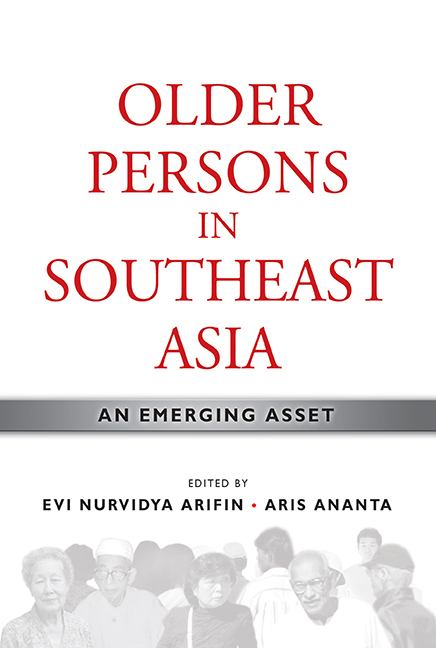Book contents
- Frontmatter
- Contents
- List of Tables
- List of Figures
- Foreword by Hal Hill
- Message from the Director
- Preface
- Contributors
- PART I INTRODUCTION
- PART II OLD-AGE INCOME SECURITY
- PART III EMPLOYMENT AND OTHER SOURCES OF FINANCIAL CONTRIBUTION
- 7 Employment of Older Persons: Diversity across Nations and Subnations in Southeast Asia
- 8 Work, Income, and Expenditure: Elderly and Near-elderly Women in Metro Cebu, Philippines
- 9 Employability Approach to Financing Old Age
- 10 Facing the Geriatric Wave in Indonesia: Financial Conditions and Social Support
- PART IV AGEING, MIGRATION, AND DEVELOPMENT
- PART V ROLES OF GOVERNMENT AND CIVIL SOCIETY
- Index
7 - Employment of Older Persons: Diversity across Nations and Subnations in Southeast Asia
from PART III - EMPLOYMENT AND OTHER SOURCES OF FINANCIAL CONTRIBUTION
Published online by Cambridge University Press: 21 October 2015
- Frontmatter
- Contents
- List of Tables
- List of Figures
- Foreword by Hal Hill
- Message from the Director
- Preface
- Contributors
- PART I INTRODUCTION
- PART II OLD-AGE INCOME SECURITY
- PART III EMPLOYMENT AND OTHER SOURCES OF FINANCIAL CONTRIBUTION
- 7 Employment of Older Persons: Diversity across Nations and Subnations in Southeast Asia
- 8 Work, Income, and Expenditure: Elderly and Near-elderly Women in Metro Cebu, Philippines
- 9 Employability Approach to Financing Old Age
- 10 Facing the Geriatric Wave in Indonesia: Financial Conditions and Social Support
- PART IV AGEING, MIGRATION, AND DEVELOPMENT
- PART V ROLES OF GOVERNMENT AND CIVIL SOCIETY
- Index
Summary
Promoting an increase in labour force participation of older persons has been high on the agenda of countries facing ageing population. It is seen as a means to deal with the issue of how to finance old age within a limited or unsustainable pension fund. As noted in Hermalin et al. (2002), working has a significant impact on the life of older persons — both for their income and health. In turn, health may have a significant effect on labour supply (Cai and Kalb 2005; Kalwij and Vermeulen 2007).
The United Nations (2001) concluded that the labour force participation rate of older persons had declined worldwide significantly, in both developing and developed countries. The reduction was greater for men than women. The rate for the population aged 65 and above declined from about 55.0 per cent in 1950 to about 30.0 per cent in 2000 for men, and from about 14.0 per cent to about 10.0 per cent in the same period for women.
At the same time, labour force participation rates are usually higher in developing countries than in developed countries. The higher rate is partly because of the limitation or non-existence of old-age income security scheme, health insurance, occupational safety, and other social safety nets. Older persons in developing countries are more likely to be forced by economic necessities to remain in the labour market. Therefore, along with the disappearance of the informal social safety net, the declining labour force participation rates among the older persons have raised concern on how to finance older persons in their old age.
From a macroeconomic point of view, delaying the retirement age and letting older persons remain at work in old age is good because it can minimize the use of retirement resources and older persons can continue to produce goods and services and hence contribute to economic growth. From a microeconomic point of view, keeping older persons at work can be useful for their active ageing and improving their psychological wellbeing, thereby, reducing the cost of health care and services, as long as the elderly are not forced by economic necessity to work.
- Type
- Chapter
- Information
- Older Persons in Southeast AsiaAn Emerging Asset, pp. 167 - 217Publisher: ISEAS–Yusof Ishak InstitutePrint publication year: 2009

